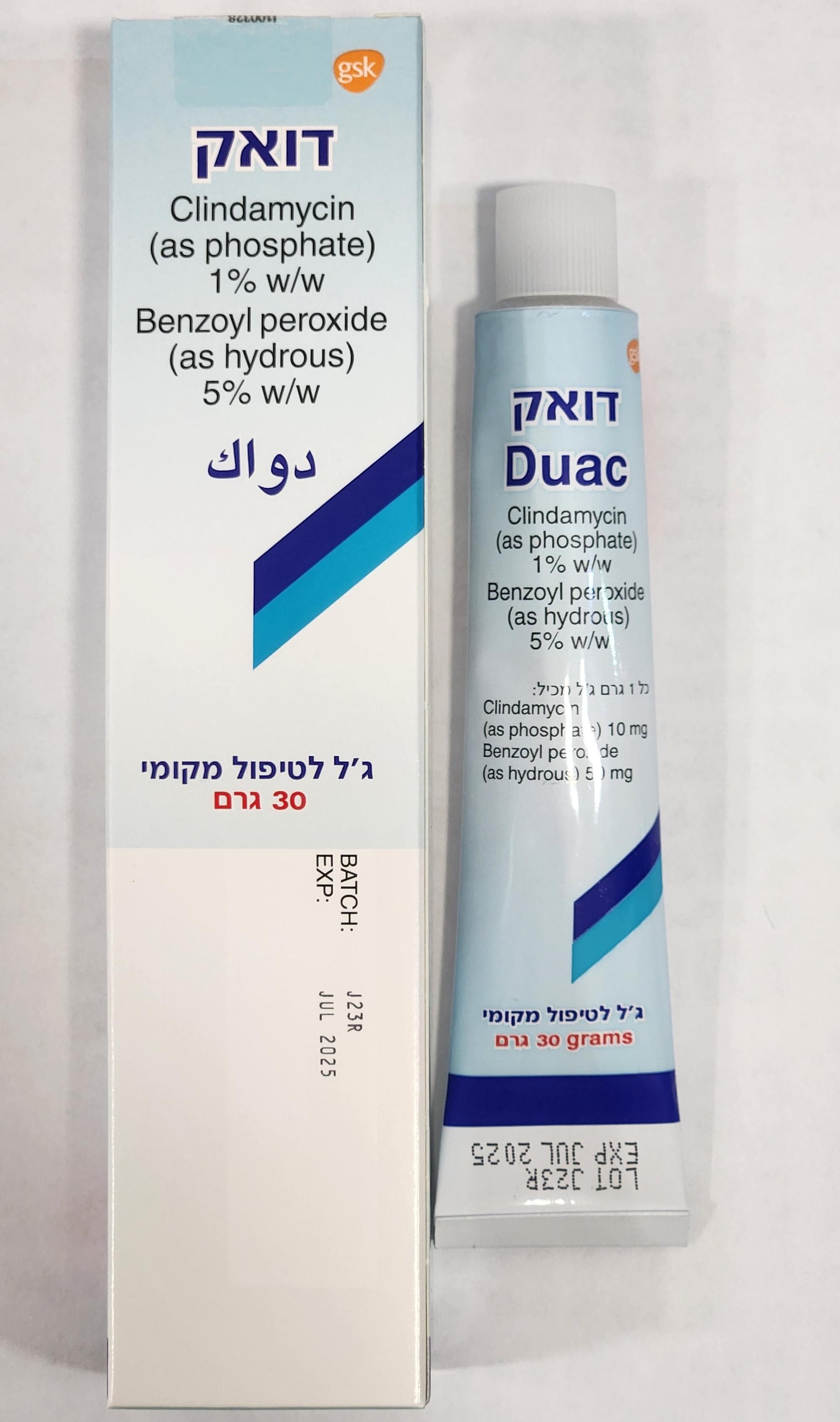Quest for the right Drug

דואק DUAC (BENZOYL PEROXIDE AS HYDROUS, CLINDAMYCIN AS PHOSPHATE)
תרופה במרשם
תרופה בסל
נרקוטיקה
ציטוטוקסיקה
צורת מתן:
חיצוני : TOPICAL
צורת מינון:
ג'ל : GEL
עלון לרופא
מינוניםPosology התוויות
Indications תופעות לוואי
Adverse reactions התוויות נגד
Contraindications אינטראקציות
Interactions מינון יתר
Overdose הריון/הנקה
Pregnancy & Lactation אוכלוסיות מיוחדות
Special populations תכונות פרמקולוגיות
Pharmacological properties מידע רוקחי
Pharmaceutical particulars אזהרת שימוש
Special Warning עלון לרופא
Physicians Leaflet
Pharmacological properties : תכונות פרמקולוגיות
Pharmacodynamic Properties
5.1. Pharmacodynamic Properties Pharmacotherapeutic group: Clindamycin, combinations ATC Code: D10AF51 Clindamycin is a lincosamide antibiotic with bacteriostatic action against Gram-positive aerobes and a wide range of anaerobic bacteria. Lincosamides such as clindamycin bind to the 23S subunit of the bacterial ribosome and inhibit the early stages of protein synthesis. The action of clindamycin is predominantly bacteriostatic although high concentrations may be slowly bactericidal against sensitive strains. Although clindamycin phosphate is inactive in-vitro, rapid in-vivo hydrolysis converts this compound to the antibacterial active clindamycin. Clindamycin activity has been demonstrated clinically in comedones from acne patients at sufficient levels to be active against most strains of Propionibacterium acnes. Clindamycin in-vitro inhibits all Propionibacterium acnes cultures tested (MIC 0.4mcg/ml). Free fatty acids on the skin surface have been decreased from approximately 14% to 2% following application of clindamycin. Benzoyl peroxide is mildly keratolytic acting against comedones at all stages of their development. It is an oxidising agent with bactericidal activity against Propionibacterium acnes, the organism implicated in acne vulgaris. Furthermore it is sebostatic, counteracting the excessive sebum production associated with acne. Duac gel has a combination of mild keratolytic and antibacterial properties providing activity particularly against inflamed lesions of mild to moderate acne vulgaris. The prevalence of acquired resistance may vary geographically and with time for selected species. Local information of resistance is desirable, particularly when treating severe infections. The inclusion of benzoyl peroxide reduces the potential for the emergence of organisms resistant to Clindamycin. The presentation of both active ingredients in one product is more convenient and ensures patient compliance. Clinical efficacy and safety In five randomized double-blind clinical studies of 1318 patients with facial acne vulgaris with both inflammatory and non-inflammatory lesions, 396 used Duac, 396 used benzoyl peroxide, 349 used clindamycin and 177 used vehicle. Treatment was applied once daily for 11 weeks and patients were evaluated and lesions counted at 2, 5, 8 and 11 weeks. The mean percentage reduction in the number of lesions after 11 weeks is shown in the table. Mean percent reduction in number of lesions from baseline after 11 weeks Study 150 Study 151 Study 152 Study 156 Study 158* (n = 120) (n = 273) (n = 280) (n = 287) (n = 358) Inflammatory lesions Duac 65 56 42 57 52 Benzoyl peroxide 36 37 32 57 41 Clindamycin 34 30 38 49 33 Vehicle 19 -0.4 29 - 29 Non-inflammatory lesions Duac 27 37 24 39 25 Benzoyl peroxide 12 30 16 29 23 Clindamycin -4 13 11 18 17 Vehicle -9 -5 17 - -7 Total lesions (inflammatory plus non-inflammatory lesions) Duac 41 45 31 50 41 Benzoyl peroxide 20 35 23 43 34 Clindamycin 11 22 22 33 26 Vehicle 1 -1 22 - 16 * Pivotal study. Statistically significant differences highlighted in bold. The reduction in total lesions was significantly greater with Duac gel than clindamycin or vehicle in all five studies. The improvement was consistently greater with Duac gel than benzoyl peroxide, but the difference did not achieve statistical significance in individual studies. Against inflammatory lesions, Duac gel was significantly superior to clindamycin alone in four of five studies and to benzoyl peroxide alone in three of five studies. Against non-inflammatory lesions, Duac gel was significantly better than clindamycin in four of five studies, and tended to be better than benzoyl peroxide alone. Overall improvement in acne was assessed by the physician and was significantly better with Duac gel than with either benzoyl peroxide or clindamycin alone in three of five studies. An effect on inflammatory lesions was apparent from week 2 of treatment. The effect on non- inflammatory lesions was more variable, with efficacy generally apparent after 2-5 weeks of treatment.
Pharmacokinetic Properties

שימוש לפי פנקס קופ''ח כללית 1994
לא צוין
תאריך הכללה מקורי בסל
לא צוין
הגבלות
לא צוין
מידע נוסף
